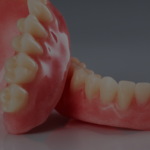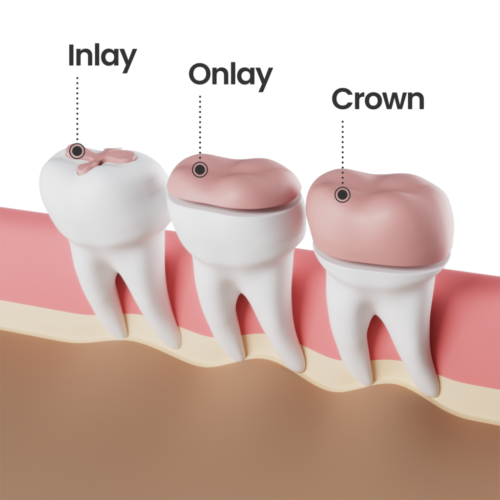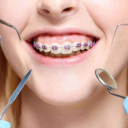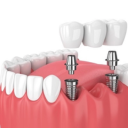
Dentures
March 11, 2024Inlays Onlays
Inlays Onlays are types of indirect fillings done on teeth. Typically fillings are done to fill small cavities
on the tooth surface. In many cases where the dental decay is so extensive that filling isn’t enough, a more
substantial tooth restoration is required to provide enough strength and support to the tooth. They are
not as invasive as a crown but more robust than fillings. Both of these are fabricated in labs and cemented
later in the tooth. Inlays fit inside the tooth in cavities and hollows in areas between cusps, just like fillings.
Whereas Onlys fit inside the tooth and cover the chewing surfaces of a back tooth to restore one or more
cusps. Onlays look like crowns but do not extend to all surfaces of a tooth. Onlays and inlays can be made
of gold, ceramic, or porcelain and are bonded to the tooth using cement. Onlays and inlay cover different areas of a tooth but serve the same function of protecting a tooth when there is decay.
Why do I need it?
When the decay in your tooth is deep, too extensive, or has caused a portion of a tooth to fracture, a
filling may not be enough to provide strength and support to your tooth. In such cases, your dentist may
choose onlays/inlays to fortify the tooth. Onlays are needed when there is decay or damage to the cusp
and chewing surface of the back tooth, and the cavity is too big to fill with standard filling materials, or the
tooth could crack. An onlay will strengthen the tooth and protect the decaying area too.
How long will it take?
The procedure of inlays/ onlays requires a minimum of two appointments. In the first appointment, the
dentist will remove the decayed part of the tooth and create a cavity that will hold the onlay/inlay. Then
he/she will take the dental impression to be sent to the lab to create the onlay/inlay. This process may
take 30 minutes to an hour. The onlay/inlay will be cemented to the tooth to fix it in place in the next
appointment. The period between the two appointments depends on the time taken by the lab to fabricate the onlays/inlay.

How long to recover? When can I get back to work?
There is no downtime for the onlay/inlay procedure, and you can immediately get back to work or resume daily activities. These are sturdy and long-lasting, lasting anywhere between 5 to 30 years.

What should the patient do before the treatment?
No preparation is needed before onlay or inlay as this is not a painful or invasive procedure.
What should the patient do after the treatment?
Before the inlay/onlay is fixed on your tooth, it is advisable to avoid eating hard food that may further
weaken or fracture the tooth. After the second appointment, you may be advised to refrain from eating
or drinking anything for one hour. It is essential to follow proper oral hygiene measures of brushing and
flossing and regular dental follow-ups to check on the stability and health of the inlays/onlays. Hard foods
and nighttime grinding may cause wear and tear of the onlay/inlays. So try to avoid hard foods and use
nightguards if you have bruxism or nighttime grinding.







